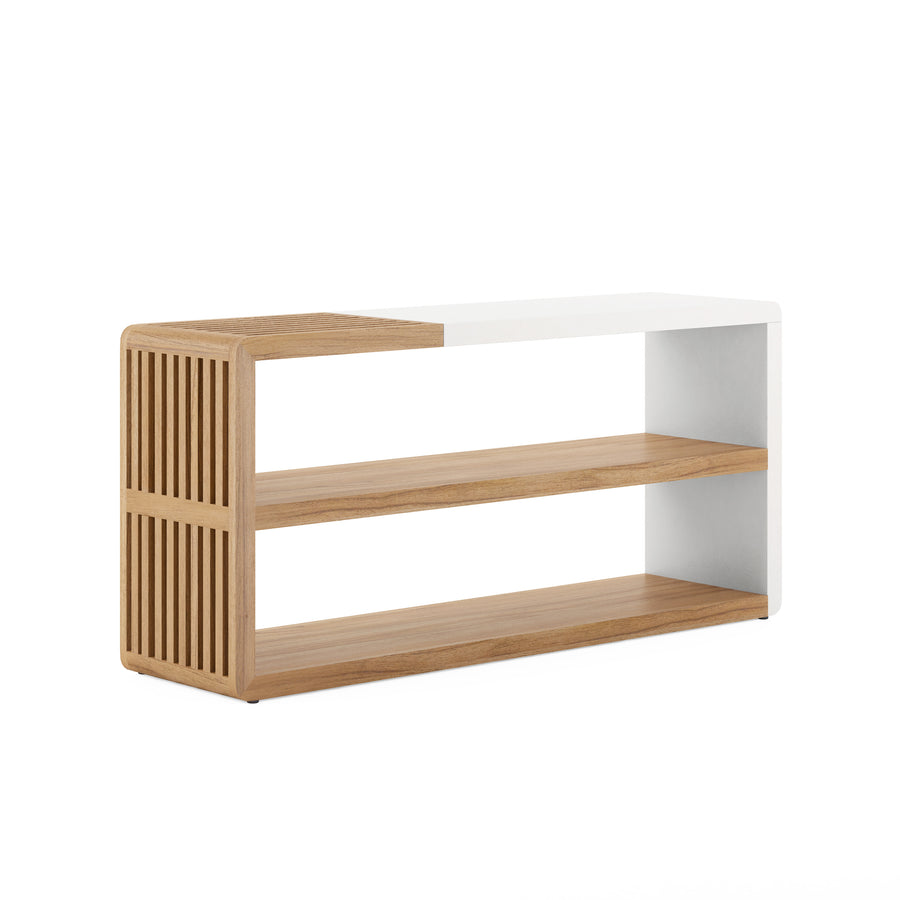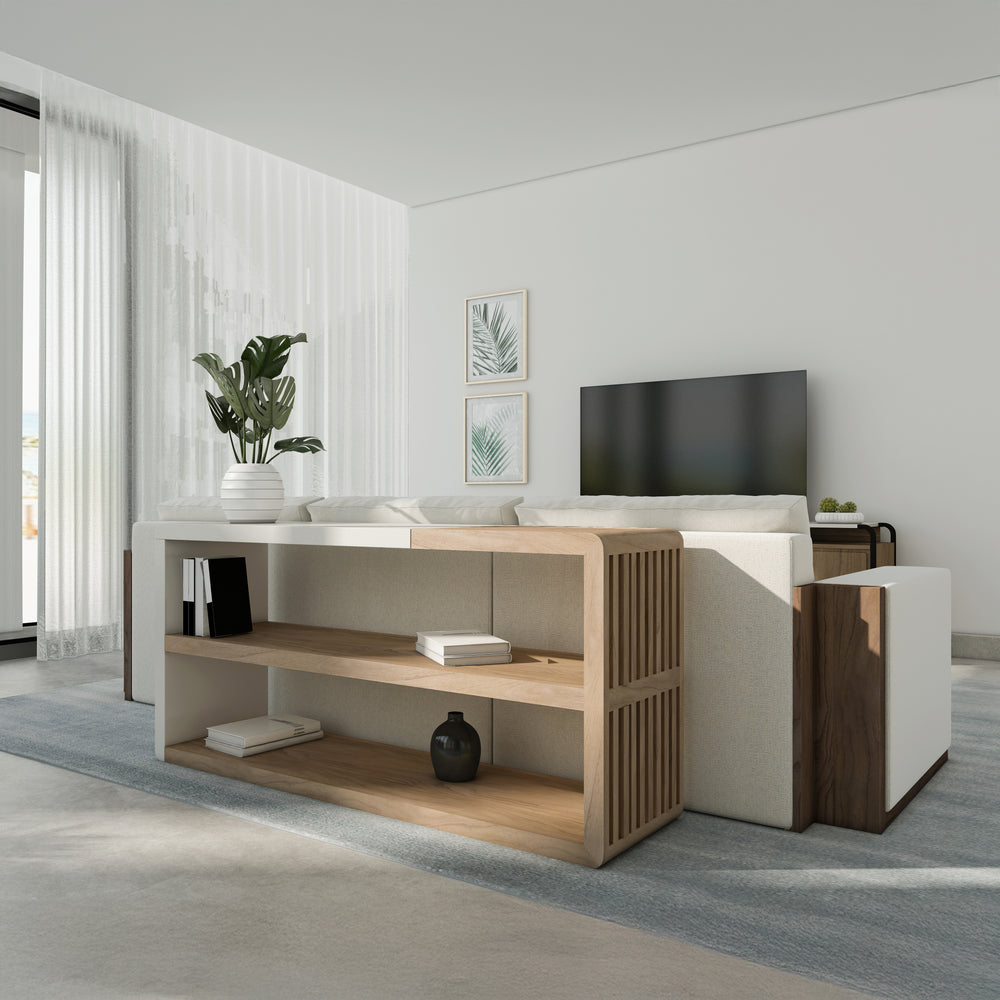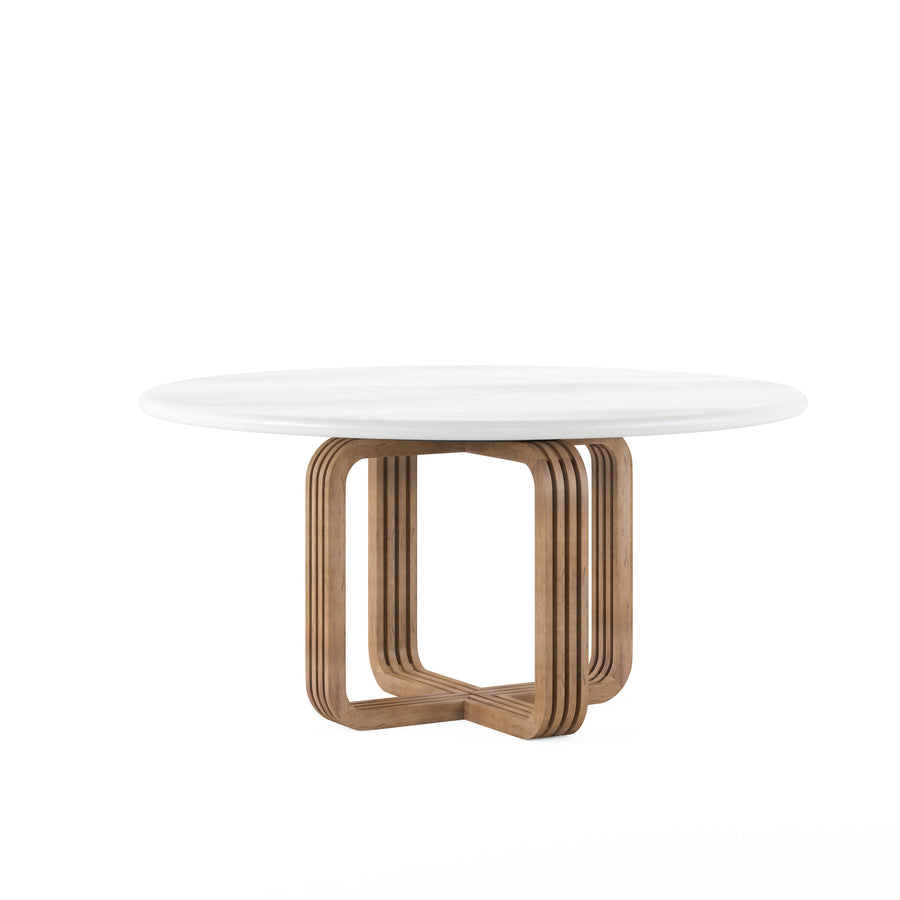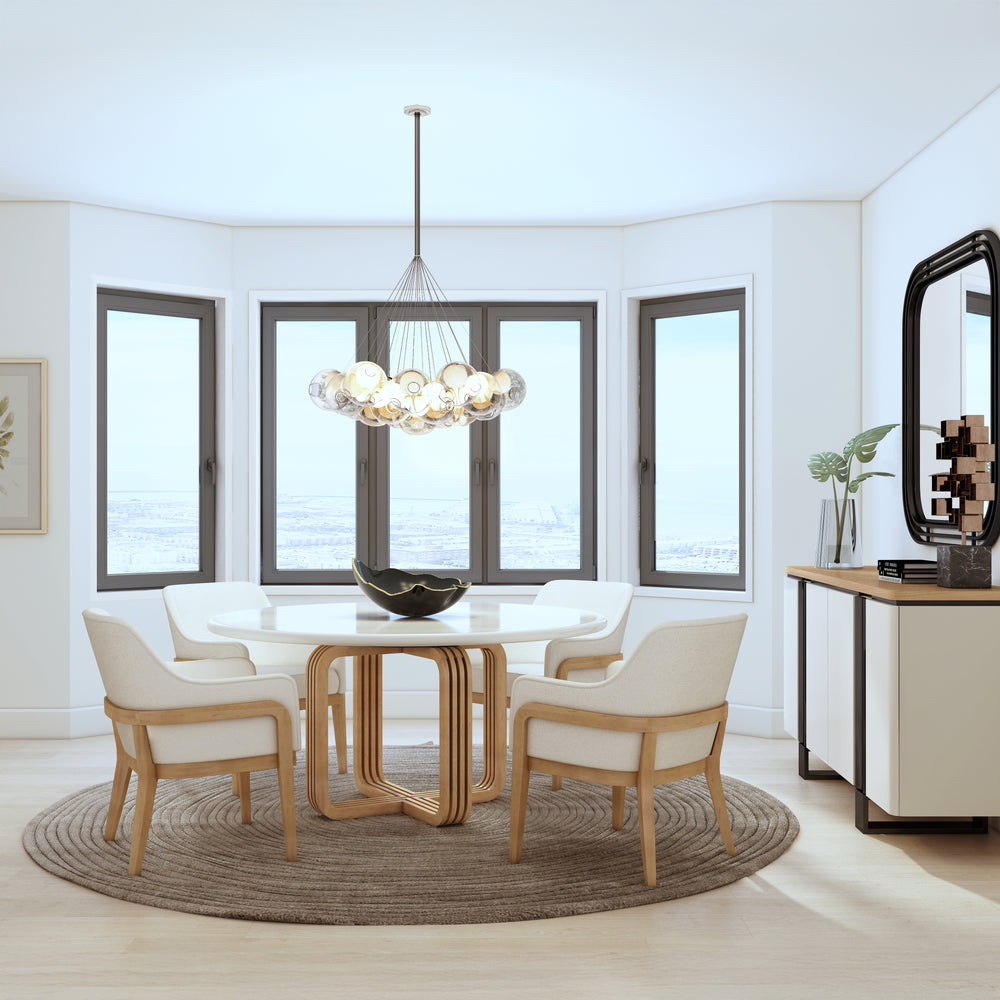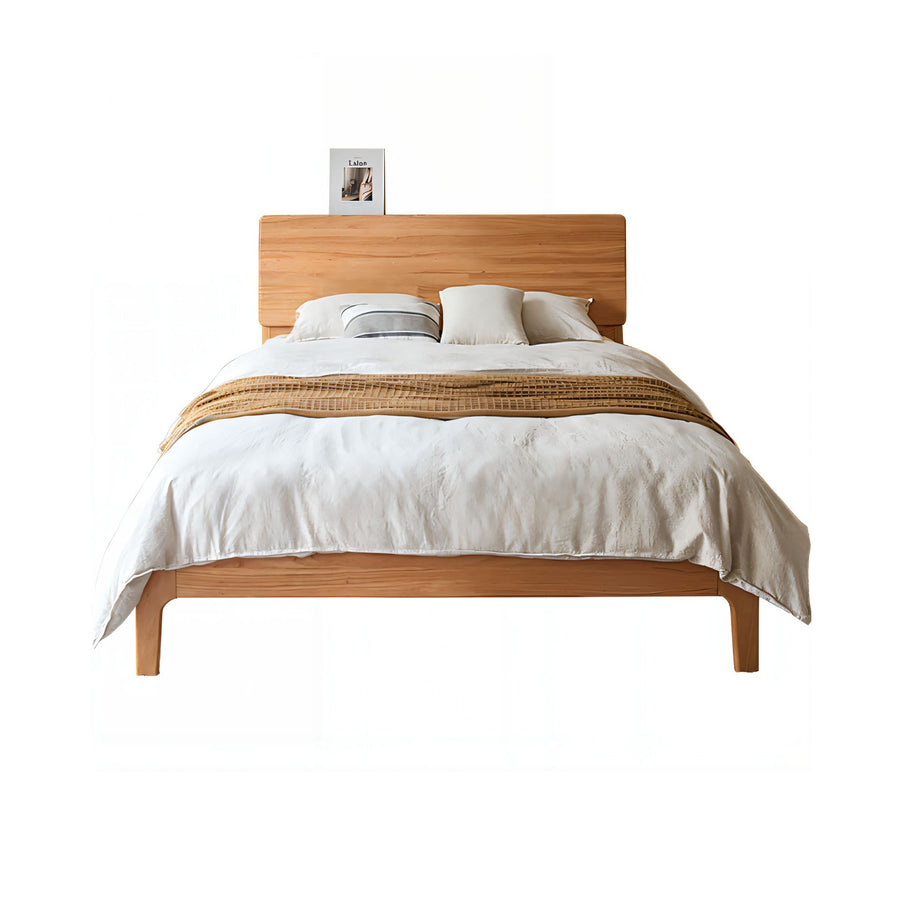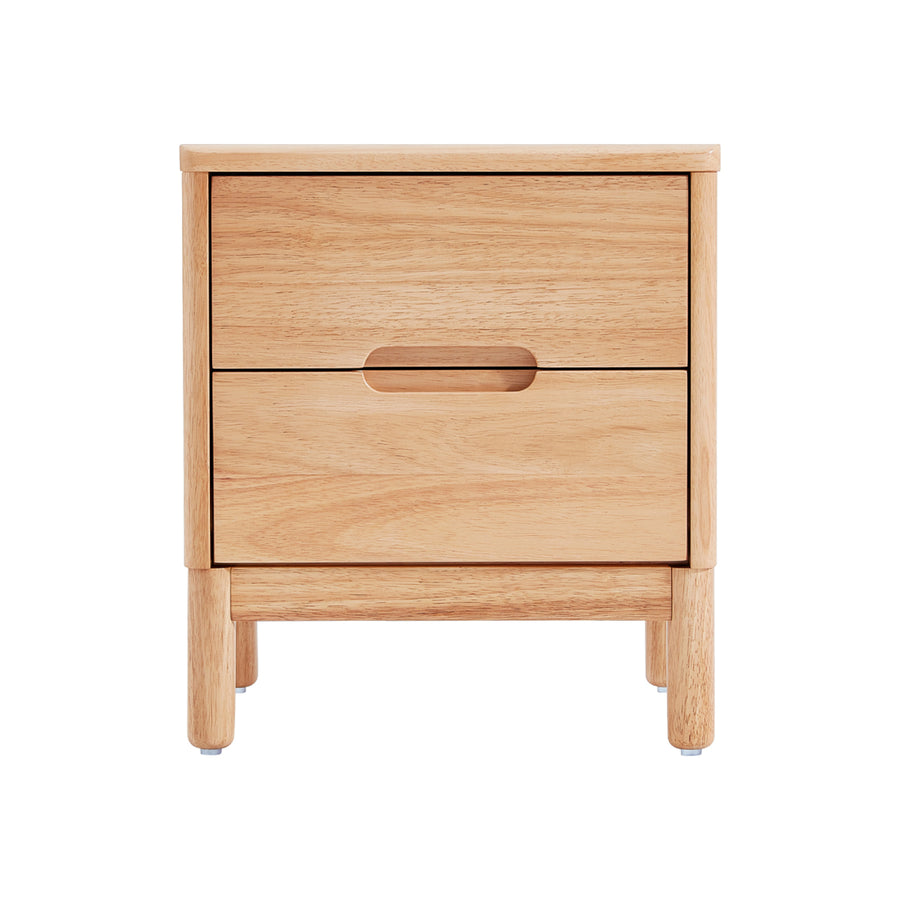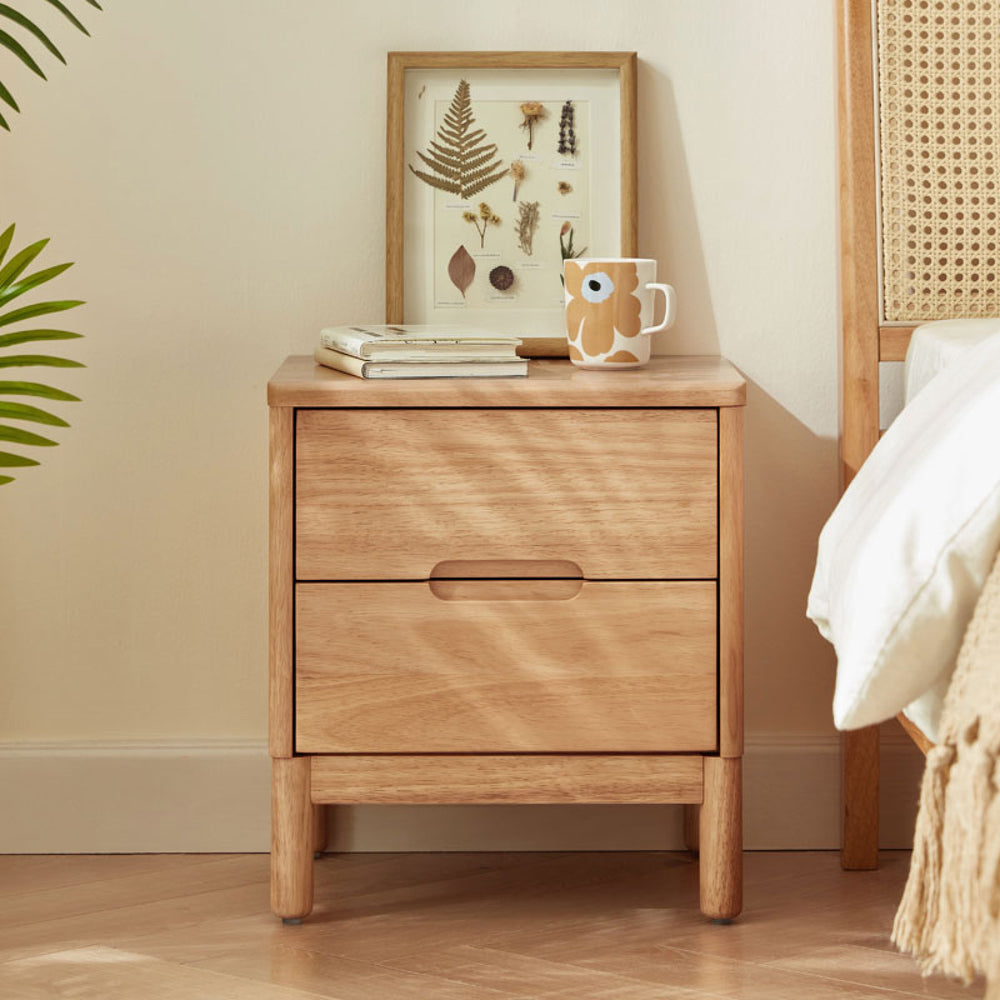Stop Guessing: Understand Solid Wood, Fibreboard, and Laminate Before You Buy
Solid-Wood vs Fibreboard vs Laminate Board
Ever wonder why one bookshelf costs twice as much as another, even if they look similar? Often, the difference comes down to what they’re made of. Furniture materials like solid wood, fibreboard (e.g., MDF or HDF), and laminate board each affect a piece’s durability, style, and price. Choosing the right material can mean the difference between a dining table that lasts for decades and one that might need replacing in a few years.
In this friendly guide, we’ll break down the differences between solid wood, fibreboard, and laminate board. You’ll learn how each material holds up in daily use, what they look like, and how they fit various budgets and home styles. By the end, you’ll be better equipped to decide which material is the best fit for your next furniture purchase.
What Is Solid‑Wood?
 Solid wood furniture is made from natural lumber cut from trees, without fillers or layers. In other words, every part of a solid-wood piece (from the surface to the interior) is real wood. Common solid woods include oak, maple, walnut, or pine, each bringing its own grain pattern and color.
Solid wood furniture is made from natural lumber cut from trees, without fillers or layers. In other words, every part of a solid-wood piece (from the surface to the interior) is real wood. Common solid woods include oak, maple, walnut, or pine, each bringing its own grain pattern and color.
This means no two solid-wood pieces are exactly alike – each has unique knots and character from the tree it came from. Solid wood furniture often showcases a rich, warm look that many consider classic and high-quality.
Pros:
Solid wood has a reputation for excellent durability. A well-made solid wood table or bed can last for generations if cared for properly. It’s sturdy and handles day-to-day use and heavy loads well (think of a solid oak dining table that stands up to years of family dinners).
Another big plus is that you can refinish or repair solid wood. If it gets scratched or the color falls out of fashion, you can sand it down, re-stain or paint it, and it will look new again. Solid wood’s natural beauty is a huge draw too – the wood grain and texture give each piece a one-of-a-kind appearance that adds warmth to any room.
Additionally, it’s a natural material (no heavy chemicals or glues inside), which appeals to those who love eco-friendly, authentic decor.
Cons:
The main drawbacks of solid wood are cost and maintenance. Solid wood furniture tends to be the priciest option upfront. High-quality timber and craftsmanship don’t come cheap, but they do offer long-term value. Solid wood is also heavier than engineered wood pieces, so moving a solid wood dresser or bed can be a workout.
In terms of care, solid wood can be sensitive to environmental changes. For example, extreme humidity or direct water exposure can cause warping or cracks over time if the wood isn’t properly sealed. You’ll want to use coasters under drinks and clean up spills promptly – water and heat can mar the finish or even damage the wood.
Moreover, some solid woods (especially softer species like pine) can dent or scratch more easily than harder materials, so a household with rowdy pets or kids might ding up a pine coffee table. Regular care like dusting and occasional polishing or oiling is recommended to keep solid wood looking its best and prevent it from drying out or cracking.
Styling and Tips:
Solid wood furniture fits well with many decor styles – from traditional to modern – due to its timeless look. A solid walnut bed frame, for instance, brings warmth and elegance to a bedroom, while a painted solid wood cabinet can suit a farmhouse or coastal theme.
To style solid wood, let the wood grain shine as a focal point or pair it with mixed materials (like a glass top or metal hardware) for contrast. For maintenance, keep solid wood pieces out of direct sunlight (to avoid fading) and away from extreme damp or dry spots. Use a wood conditioner or polish annually to maintain moisture in the wood.

With a little TLC, your solid wood furniture can stay beautiful and sturdy for years. For example, the Lisandro Wooden Frame Bed (Queen) – a solid-wood bed frame – offers natural grain patterns that create a cozy, high-quality centerpiece in a bedroom (and it can be found on our site) and the Portico White Wood Rectangular Dining Table provides a bright, elegant dining space made entirely of solid wood. These pieces show how solid wood can elevate both the look and longevity of your furniture.
Understanding Fibreboard
Fibreboard is an engineered wood product made by compressing wood fibers with adhesives under high pressure and heat. Instead of solid lumber, fibreboard uses wood remnants (like sawdust or wood chips) broken down into fine fibers, mixed with resin glue, and pressed into boards.
Two common types are MDF (Medium-Density Fibreboard) and HDF (High-Density Fibreboard). MDF is the most widely used in furniture; it’s a dense, flat board with a very smooth surface. HDF is similar but made with a higher density (more compressed fibers), resulting in an even harder, thinner board often used for things like laminate flooring or cabinet backings. Fibreboard panels have no visible wood grain – they’re uniform in texture and are usually painted or laminated for a finished look.
Pros:
The biggest advantage of MDF or other fibreboard furniture is that it’s budget-friendly. Because it’s made from wood by-products and recycled fibers, it typically costs much less than solid wood. This makes fibreboard a great choice for stylish furniture on a smaller budget.
Despite the lower cost, fibreboard can be quite stable. It doesn’t have the natural grain of wood that expands or contracts as humidity changes, so a fibreboard shelf won’t warp as easily through seasonal changes. The surface of MDF is perfectly smooth and free of knots, which is ideal for painted furniture or for adding a veneer/laminate on top.
In fact, you’ll often find fibreboard as the core material for cabinets and bookshelves with a painted finish or a wood-look laminate exterior. It’s also considered easy to work with in manufacturing – you can cut and shape it precisely (great for modern designs or intricate detail on engineered wood moldings).
And since it uses recycled wood fibers, one could argue it reduces waste (though it does use chemicals in the glue). Fibreboard is also relatively low-maintenance: it doesn’t demand oiling or special polishes; just a regular wipe-down keeps it clean.
Cons:
On the downside, fibreboard (MDF in particular) isn’t as strong or long-lasting as solid wood. In terms of durability, MDF is dense and heavy, but not as structurally sturdy – if a fibreboard bookshelf is overloaded with a lot of heavy books, the shelves can sag over time unless they’re thick or well-supported.
It also doesn’t hold screws and nails as firmly as natural wood does, especially if you screw into the edge of a board; too much force can cause the material to split or the screw to loosen in the fibre. Moisture is a major enemy of fibreboard. If MDF gets soaked (say a water spill that isn’t cleaned, or prolonged high humidity), it can absorb water, swell up, and even crumble apart.
Unlike solid wood which might dry out and be refinishable after minor water damage, swollen MDF is usually not salvageable. For that reason, you won’t want to use fibreboard furniture in damp areas (and most MDF furniture is for indoor use only). Additionally, fibreboard pieces are usually veneered or painted because the raw board isn’t pretty – if the surface layer gets chipped or damaged, the brown fiber core will show through and it’s not easy to repair (you can’t simply sand and restain it like solid wood).
Also, while newer products are improving, historically MDF has contained formaldehyde-based glues (a potential air-quality issue), though many manufacturers now offer low-formaldehyde or CARB2 compliant panels for safety. In short, fibreboard furniture is best for light to moderate use pieces, not heirloom-quality items. Expect a shorter lifespan than solid wood – maybe some years of good use, but it likely won’t be handed down to your grandkids.
Styling and Tips:
Fibreboard is extremely common in modern, affordable furniture – think of those sleek painted TV stands or the minimalist white bookshelves you might find at big-box stores. Because it’s usually covered with a finish, it can mimic many looks.
For instance, an MDF media console might have a smooth white lacquer paint that looks very contemporary, or an engineered wood dresser might have a thin wood veneer giving it the appearance of oak or walnut. Style-wise, fibreboard works great for clean, painted colors and is often used in styles where cost is a factor (contemporary flats, kids’ furniture, etc.).
Basic care for fibreboard furniture includes keeping it dry (wipe up any spills immediately) and dusting or gently cleaning with a damp (not wet) cloth as needed. Avoid dragging it around too much – heavy handling can loosen joints. If assembling flat-pack MDF furniture, be careful not to over-tighten screws (follow the instructions and use the proper fittings, often cam locks or specialized screws, which are designed for MDF).
Once set up, try not to disassemble and reassemble such furniture repeatedly; fibreboard joints wear out faster with a lot of movement. For storage pieces like cabinets or bookcases made of fibreboard, it’s a good practice to use wall anchors for stability (since the material is heavy, tall MDF bookshelves can be a tip hazard if not secured).
You can explore many affordable designs built with fibreboard – for example, browse our fibreboard storage solutions collection to see sturdy yet budget-friendly shelves and cabinets that use engineered wood smartly to provide functional storage at a great price.
Why Laminate Board Shines
Laminate board furniture is all about combining materials to get the best of both worlds: you typically have a core made of particleboard or MDF, and a top layer called a laminate that’s essentially a printed, hard plastic surface.
In construction, a laminate board is like a sandwich – the middle is an engineered wood (providing strength and shape), and the exterior is a thin sheet of laminate decorative layer bonded to it. This laminate surface can have almost any look or color you can imagine: common options include laminates that mimic wood grain, solid colors, or even patterns and textures.
High-pressure laminates (like Formica) are made to be very durable and are often used on countertops and desks; low-pressure laminates (like melamine coatings) are used on many ready-to-assemble furniture pieces. The result is furniture that isn’t “wood” through-and-through, but has a clean, finished surface that’s attractive and tough.
Advantages of Laminate:
This is where laminate really shines – it offers exceptional surface durability and variety. The laminate top layer is engineered to resist scratches, stains, and even heat to a large extent. That means you can be a bit less nervous using a laminate coffee table for game night snacks and drinks, or letting your kids do homework (or art projects!) on a laminate desk.
It won’t dent as easily as a soft wood, and you won’t typically get water rings or burn marks from a hot mug as you might on real wood veneer. Laminate furniture is also super easy to clean – usually just a wipe with a damp cloth is enough since the surface is non-porous and doesn’t need special polishes.
In terms of style, laminates come in endless options. Want a bookshelf that looks like espresso oak, or one in a bright teal gloss finish? There’s likely a laminate for that. Manufacturers can design laminate surfaces with any color or pattern, allowing laminate furniture to keep up with the latest design trends. You can get the look of exotic wood or a bold color that might be hard to achieve affordably with real wood.
Another big plus: affordability. Laminate-covered furniture is generally cheaper than comparable solid wood or wood veneer pieces. You’re not paying for thick hardwood panels, just a printed layer and an MDF/particle core, which keeps costs down. This makes laminate a star for budget-conscious shoppers who still want a stylish look.
It’s also lightweight relative to solid wood (the core is often lighter particleboard), so things like laminate dressers or desks can be easier to move around. For those who like a modern or modular aesthetic, laminate furniture often provides sleek lines and consistency (every piece of a laminate set will match in color and grain exactly, which is hard to guarantee with natural wood).
In summary, laminate furniture delivers durability in daily use (great for high-traffic pieces or kids’ rooms) and offers a huge range of looks, all at a lower price point – a bright combination of perks.
Minor Drawbacks:
Laminate furniture isn’t perfect, of course. Because the beauty is only skin-deep (the wood-look or color is just a printed surface), you can’t refinish or repair it the way you can with solid wood.
If the laminate layer gets deeply scratched or starts to peel at an edge, you can’t sand it down or re-stain it – you’re pretty much stuck with that damage or you have to replace the panel/piece. Fortunately, minor surface wear is rare due to its toughness, but if it does happen (say a sharp object gouges it), the brown or white core might show through.
Speaking of edges, sometimes the laminate can chip or lift at corners or along edges after years of use – for example, the desk edge might lose a bit of its plastic coating if bumped repeatedly. This is mostly an issue in older or low-quality laminates; higher-end products often have better edge banding to prevent it.
Another consideration is strength: the strength of laminate furniture depends on its core (often particleboard), which isn’t as robust as solid wood. So while the surface won’t easily scratch, a laminate bookshelf still can sag under very heavy weight like an MDF one would, and a laminate table won’t be as inherently sturdy as a solid wood table for holding extremely heavy loads.
In general, well-made laminate pieces are plenty strong for normal use, but you wouldn’t, say, stand on a cheap laminate bookshelf (whereas a solid wood shelf might hold up). Aesthetic purists might note that laminate, while nice, lacks the natural feel – it’s uniformly made, so it doesn’t have the unique grain or warmth of real wood. To the touch, it’s a hard plastic feel rather than wood.
Some also avoid laminates for environmental reasons: they are plastic-based and not as easily recyclable at end of life. However, many companies are improving laminate production to be greener. Buying quality (so it lasts) and from reputable manufacturers can mitigate some concerns.
Lastly, longevity: laminate furniture can actually last quite a long time, but when it does start to wear out, it’s not as easily rejuvenated as solid wood. You’ll likely replace laminate pieces once they’re worn or styles change, rather than refinishing them. Despite these drawbacks, for many people the trade-off is worth it – you get a very resilient, good-looking piece now, at a fraction of the cost of solid wood.
Styling and Use Cases:
Laminate board furniture is extremely versatile in style. It’s common in modern and contemporary designs, where clean lines and glossy or consistent finishes are desired. For instance, a TV stand might have a grey oak laminate finish that looks just like wood grain but is far more scratch-resistant (perfect for holding electronics and decor without worry).
Office furniture frequently uses laminates – think of those durable office desks and filing cabinets with wood-look tops that resist coffee spills and pen marks. If your home has a modern minimalist vibe, a white laminate bookshelf or a black lacquer-like coffee table could fit right in. For kids’ rooms or dorms, laminates are a smart choice because they can handle some abuse and are easy to clean (crayon marks won’t seep in!). You can find laminates in almost any color, which is great for playful designs.
One minor tip: pair laminate furniture with some softer textures in your room (like a fabric throw or natural decor) to avoid an overly plastic feel in the decor. When cleaning laminate, avoid abrasive scrubbers that might scratch the surface; simply use a soft cloth with mild cleaner.
Edge care is important – if you ever notice a laminate edge starting to loosen, a tiny bit of wood glue and clamping can re-seal it before it becomes a big peel. Overall, laminate furniture truly shines when you need something that looks good, handles daily life with ease, and stays on budget. Be sure to discover our versatile laminate furniture collection to see examples – you’ll find pieces that showcase how far laminates have come in imitating high-end looks while remaining extremely user-friendly.
Choosing the Right Material for Your Home
Now that we’ve looked at solid wood, fibreboard, and laminate in detail, how do you decide which is right for you? It often comes down to balancing cost, durability, and style for your specific needs. Here’s a quick side-by-side comparison and some tips for choosing:
1. Durability & Longevity:
Solid wood is the heavyweight champ in terms of longevity – a quality solid-wood piece can last decades (or even become a vintage heirloom). It’s very strong for holding weight and can be refinished to extend its life.
Fibreboard (MDF/HDF) furniture is moderately durable: it will serve well for years, but it’s susceptible to sagging under heavy loads and can be ruined by water damage, so its lifespan is shorter.
Laminate furniture falls somewhere in between. The laminated surface won’t wear quickly and protects the piece from scratches and stains, but remember the core is typically MDF/particleboard. Laminate items can last a long time if well cared for, but they are generally not as structurally indestructible as solid wood. If you need something for the long haul and heavy use – say a dining table your family will use daily and you want to keep forever – solid wood is a top choice. For medium-term or lighter-duty use (like a trendy bookshelf or a desk for a student), engineered wood or laminate can be perfectly sufficient.
2. Cost & Budget:
If budget is a primary concern, fibreboard and laminate furniture have the edge. They are usually significantly cheaper than solid wood while still offering a nice look. Solid wood is an investment – you pay more upfront for quality and longevity.
One way to think of it: solid wood might cost more now but could save money in the long run because you won’t need to replace it (and it retains value better). However, if you’re furnishing your first apartment or need lots of pieces at once, mixing in fibreboard/laminate items is budget-friendly.
You might choose a solid wood statement piece (like a bed frame or dining table) and complement it with laminate side tables or fibreboard shelving to stay on budget. Always consider the importance of the piece: for something like a mattress support (bed frame) or a cabinet hinge support, spending more for solid wood or at least high-quality engineered wood is wise. For more decorative or low-stress pieces, cheaper materials are fine.
3. Style & Appearance:
For a classic or high-end look, solid wood often wins because of its authentic grain and heft – it’s what you’ll see in traditional or luxury furniture settings. If you love the character of wood and want each piece to be unique, solid wood is very rewarding.
Fibreboard furniture usually doesn’t showcase natural wood (unless it has a thin veneer), so it’s often painted or coated – this lends itself well to modern, clean designs or fun colors. If your style is modern, minimalist, or you want bold painted furniture (like an emerald green cabinet), fibreboard is a great canvas for that.
Laminate can mimic any style – you can find laminate furniture that looks like mid-century walnut, rustic weathered wood, or ultra-modern glossy white. So for style, laminate is a chameleon: it’s great when you want a specific look without the expense. The downside is laminate surfaces, while pretty, lack variation – every panel will look identical, which can be a pro or con depending on your preference (uniformity vs. natural variation).
In a space where you want a pop of color or a sleek finish, laminates are fantastic. In a space where you want genuine warmth or a prestigious feel, sprinkle in some solid wood. Also consider texture: solid wood and some veneers have a tactile grain; laminates are usually smooth. You can mix materials in a room for contrast – for example, a solid wood dining table with laminate wood-look chairs can balance cost and style.
4. Maintenance & Care:
Think about how much effort you’re willing to put into care. Solid wood isn’t hard to care for, but it does require a bit more mindfulness (coasters, gentle cleaning, maybe polishing wax now and then). It might also need tightening of screws or glue repairs over many years as wood can loosen slightly.
Fibreboard and laminate furniture are generally low-maintenance: just keep them dry and dusted. You won’t be refinishing them; if they get damaged beyond a certain point, replacement is usually the solution.
In a household with young children, for instance, a durable laminate coffee table might save you worry over spills and coloring accidents compared to a pricey hardwood table. For a rarely used formal room, a solid wood display cabinet might be fine and only needs occasional dusting. So consider the use case: high-traffic, mess-prone area -> laminate or sturdy finished MDF might be more forgiving. Low-traffic, showcase area -> solid wood can shine (literally and figuratively).
5. Environmental Impact:
If sustainability is a factor for you, each material has pros and cons. Solid wood is natural and can be sustainably sourced (look for FSC-certified wood). It’s long-lasting, which is eco-friendly in that you’re not disposing of it often.
Fibreboard uses recycled wood fibers, which is efficient, but the binding resins can off-gas (ensure it meets safety standards). It’s also not as long-lived, often ending up discarded sooner.
Laminate involves plastics and is not easily recyclable at end of life. However, many companies are improving laminate production to be greener. Buying quality (so it lasts) and from reputable manufacturers can mitigate some concerns. From a longevity standpoint, solid wood kept for 50 years is less wasteful than replacing a laminate piece every 5-10 years. But if you take good care of engineered wood furniture, you can extend its life considerably.
6. Style Fit Tips:
Ultimately, match the material to the purpose. For a forever piece that you want to age gracefully with your home, go for solid wood – it will develop character and can even be refinished to match decor changes (for example, you can repaint a solid wood dresser if you remodel the room).
For trendy or seasonal furniture – maybe a particular color or style you might change in a few years – laminates are a smart choice since they’re affordable and stylish, and you won’t feel as bad replacing them when it’s time.
Fibreboard furniture is excellent for pieces that need to look good and function well without breaking the bank, like a home office desk or a TV console. Just be mindful to choose quality MDF pieces (check that joints are sturdy, shelves are thick enough, etc.). If you love DIY, solid wood is more adaptable (sanding, staining), while fibreboard/laminate is not very DIY-friendly beyond maybe a new coat of paint on MDF.
Also consider mixing materials in a single piece: some furniture is made with solid wood frames and fibreboard panels, combining strength with cost-saving – these can be great options to get a happy medium.
In summary, there’s no one “best” material – it’s about finding what best suits your needs. Solid-wood vs fibreboard vs laminate board each has its place. Solid wood excels in durability and classic beauty (at a higher cost), fibreboard offers smooth finishes and affordability for stylish pieces, and laminate provides an unbeatable combo of variety and easy care for busy homes. Many households use a mix of all three types throughout different rooms!
Conclusion
When choosing furniture, keep in mind how each material will serve you. Solid wood, fibreboard, and laminate all offer different strengths: the first for timeless quality, the second for value and versatility, and the third for durability and design options.
By weighing your priorities – be it longevity, budget, or style – you can pick the material that makes the most sense for your piece. The good news is that today’s manufacturing has improved all these materials, so you can find well-made products in each category.
Ready to find your perfect piece? Explore our solid‑wood, fibreboard, and laminate options today → Browse All Furniture. Whether you want an investment piece that will last a lifetime or something stylish and practical for right now, you’ll be sure to find furniture that fits your home and lifestyle. Enjoy the process of choosing, knowing that you’re now equipped with the knowledge to make an informed decision on solid-wood vs fibreboard vs laminate board!

